On the Fidelity of RANS-Based Turbulence Models in Modeling the Laminar Separation Bubble and Ice-Induced Separation Bubble at Low Reynolds Numbers on Unmanned Aerial Vehicle Airfoil
Abstract
:1. Introduction
1.1. Laminar Separation Bubble (LSB)
1.2. Ice-Induced Separation Bubble (ISB)
1.3. RANS-Based Turbulence Model for Prediction of LSBs and ISBs
2. Numerical Methodology
2.1. Turbulence Model
2.2. Computational Model
3. Results and Discussion
3.1. Laminar Separation Bubbles (LSBs)
3.2. Fidelity of RANS Models in Predicting Laminar Separation Bubbles (LSBs)


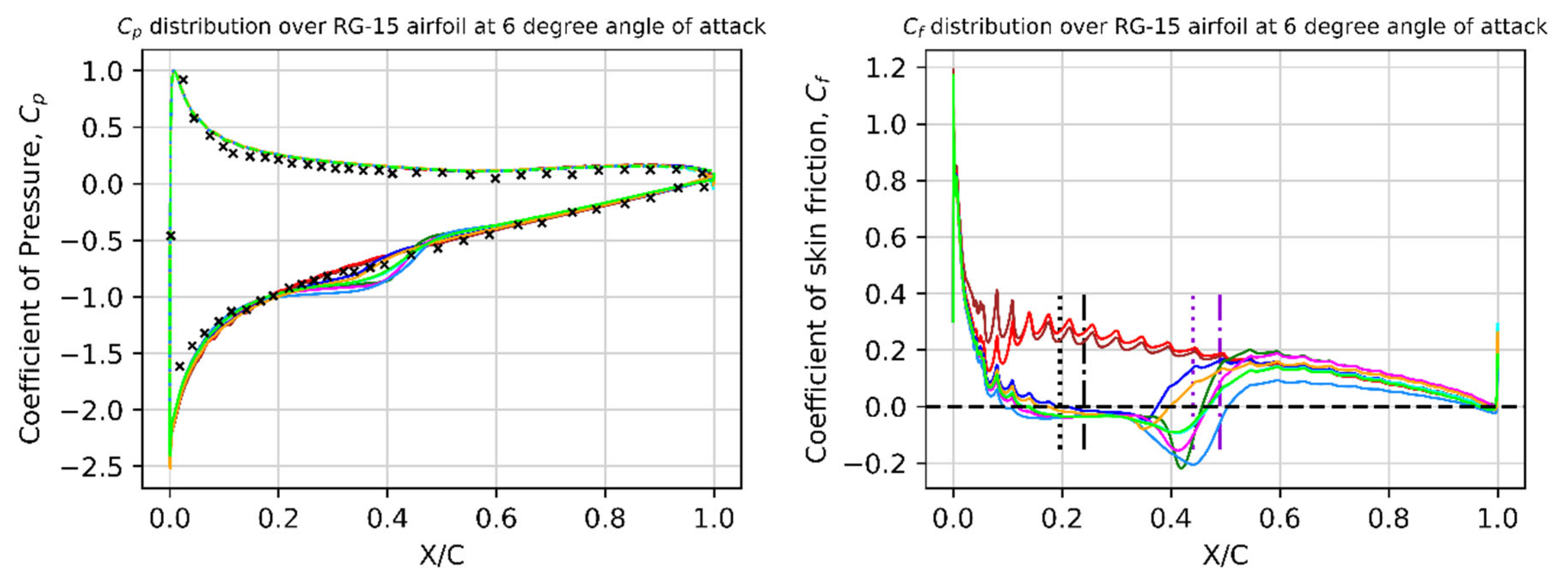
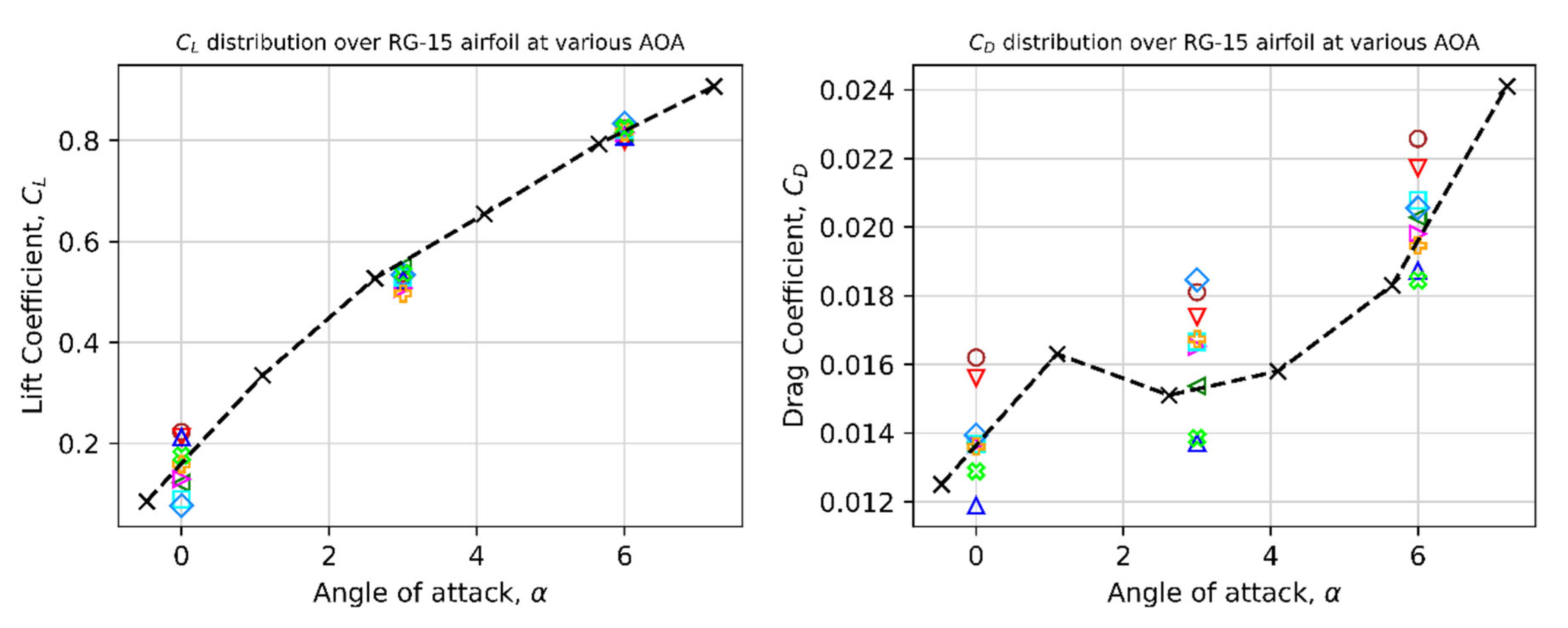
3.3. Ice-Induced Separation Bubbles (ISBs)
3.4. Fidelity of RANS Models in Predicting Ice Induced Separation Bubbles (ISBs)
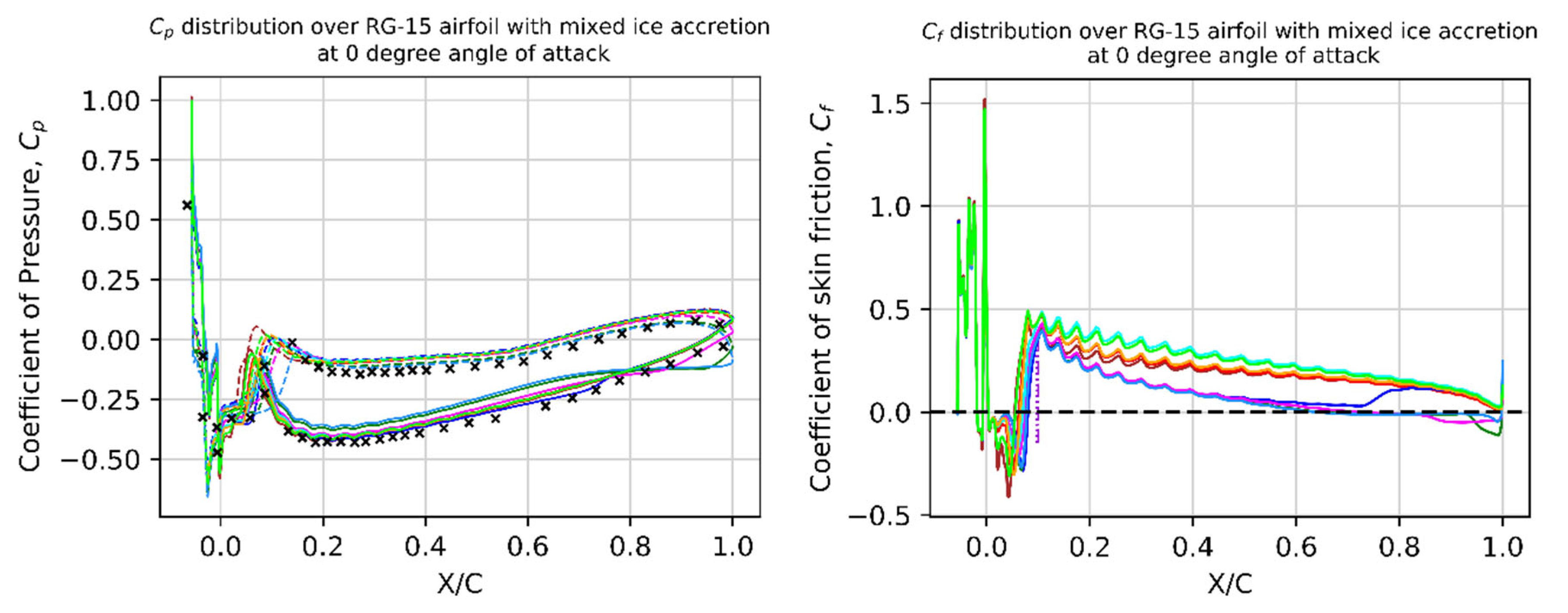


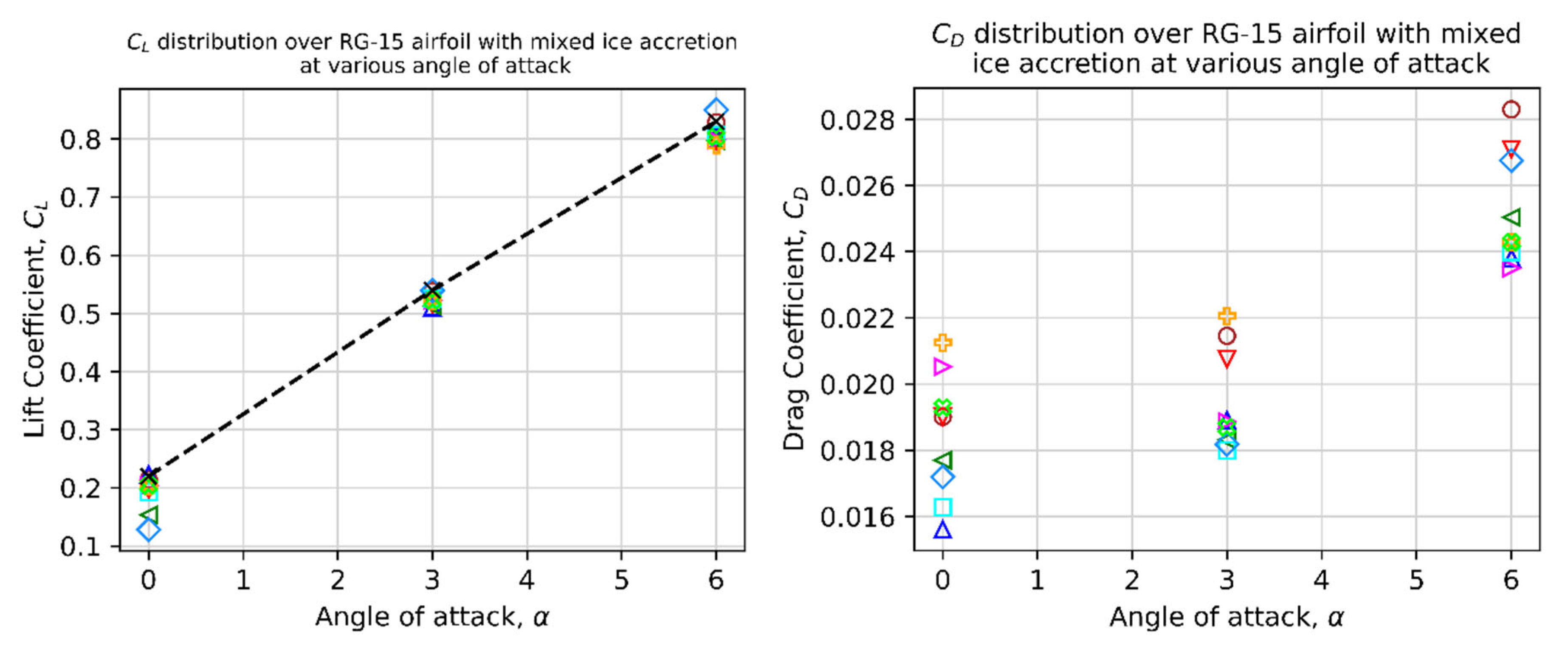
4. Conclusions
Author Contributions
Funding
Data Availability Statement
Conflicts of Interest
Appendix A

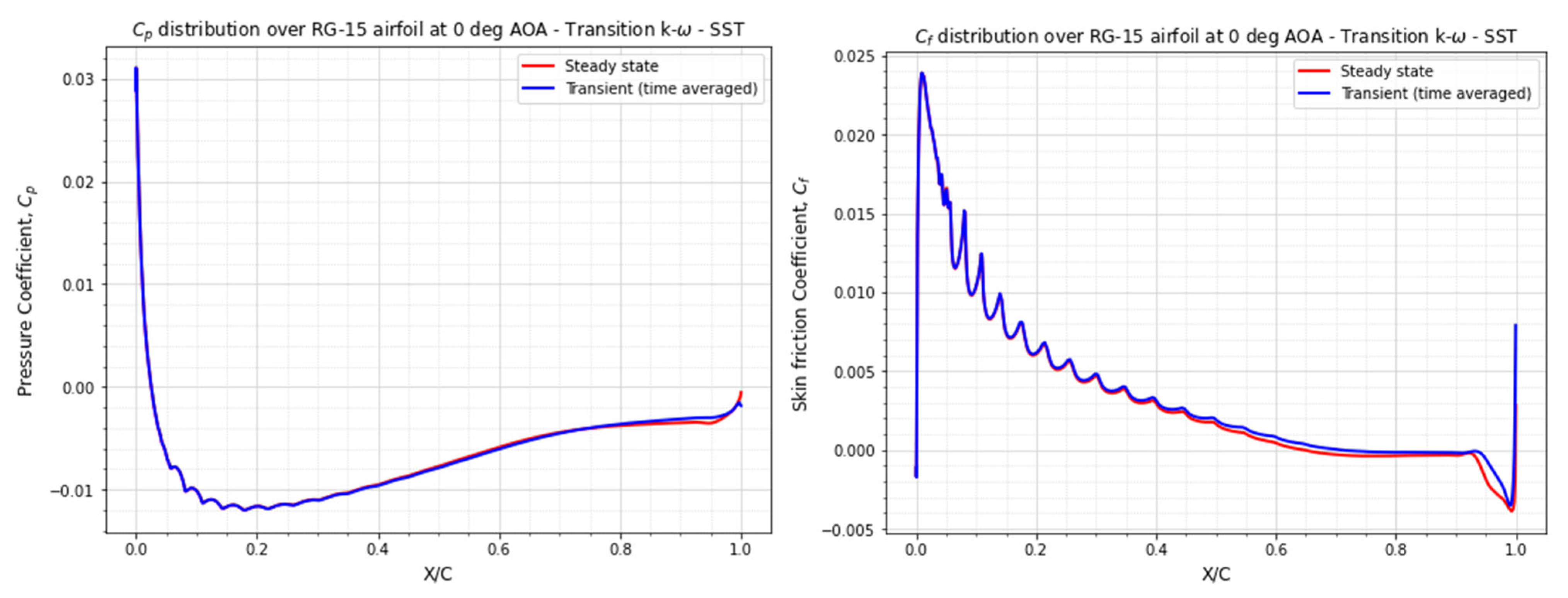
References
- Oo, N.L.; Richards, P.; Sharma, R. Influence of an ice-induced separation bubble on the laminar separation bubble on an RG-15 airfoil at low Reynolds numbers. In Proceedings of the AIAA Aviation 2020 Forum, Virtual, 15–19 June 2020. [Google Scholar]
- Tani, I. Low-speed flows involving bubble separations. Prog. Aerosp. Sci. 1964, 5, 70–103. [Google Scholar] [CrossRef]
- BRAGG, M.; Khodadoust, A. Experimental measurements in a large separation bubble due to a simulated glaze ice shape. In Proceedings of the 26th Aerospace Sciences Meeting, Reno, NV, USA, 11–14 January 1988; p. 116. [Google Scholar]
- Muhammed, M.; Virk, M.S. Ice Accretion on Fixed-Wing Unmanned Aerial Vehicle—A Review Study. Drones 2022, 6, 86. [Google Scholar] [CrossRef]
- Muhammed, M.; Virk, M.S. Ice Accretion on Rotary-Wing Unmanned Aerial Vehicles—A Review Study. Aerospace 2023, 10, 261. [Google Scholar] [CrossRef]
- Oo, N.L.; Richards, P.J.; Sharma, R.N. Ice-Induced Separation Bubble on RG-15 Airfoil at Low Reynolds Number. AIAA J. 2020, 58, 5156–5167. [Google Scholar] [CrossRef]
- ANSYS. ANSYS FENSAP-ICE User Manual 18.2; ANSYS: Canonsburg, PA, USA, 2017. [Google Scholar]
- Marxen, O.; Rist, U. DNS and LES of the Transition Process in a Laminar Separation Bubble. In Proceedings of the Direct and Large-Eddy Simulation V; Springer: Dordrecht, The Netherlands, 2004; pp. 231–240. [Google Scholar]
- Loth, E. Numerical approaches for motion of dispersed particles, droplets and bubbles. Prog. Energy Combust. Sci. 2000, 26, 161–223. [Google Scholar] [CrossRef]
- Hain, R.; Kähler, C.; Radespiel, R. Dynamics of laminar separation bubbles at low-Reynolds-number aerofoils. J. Fluid Mech. 2009, 630, 129–153. [Google Scholar] [CrossRef]
- Jones, B.M. Stalling. Aeronaut. J. 1934, 38, 753–770. [Google Scholar] [CrossRef]
- Horton, H.; Young, A. Some results of investigations of separation bubbles (Flow separation bubble data, and comparisons with velocity and pressure measurements). AGARD CP 1966, 779–811. [Google Scholar]
- Horton, H.P. Laminar Separation Bubbles in Two and Three Dimensional Incompressible Flow. Ph.D. Thesis, Queen Mary University of London, London, UK, 1968. [Google Scholar]
- Choudhry, A.; Arjomandi, M.; Kelso, R. A Study of Long Separation Bubble on Thick Airfoils and Its Consequent Effects. Int. J. Heat Fluid Flow 2015, 52, 84–96. [Google Scholar] [CrossRef]
- Gray, V.H. Aerodynamic Effects Caused by Icing of an Unswept NACA 65A004 Airfoil; National Advisory Committee for Aeronautics: Washington, DC, USA; Lewis Flight Propulsion Lab: Washington, DC, USA, 1958. [Google Scholar]
- Kim, H.; Bragg, M. Effects of leading-edge ice accretion geometry on airfoil performance. In Proceedings of the 17th Applied Aerodynamics Conference, Norfolk, VA, USA, 28 June–1 July 1999. [Google Scholar]
- Lee, S.; Bragg, M.B. Experimental Investigation of Simulated Large-Droplet Ice Shapes on Airfoil Aerodynamics. J. Aircr. 1999, 36, 844–850. [Google Scholar] [CrossRef]
- Lee, S.; Bragg, M.B. Investigation of Factors Affecting Iced-Airfoil Aerodynamics. J. Aircr. 2003, 40, 499–508. [Google Scholar] [CrossRef]
- Lee, S.; Kim, H.; Bragg, M. Investigation of factors that influence iced-airfoil aerodynamics. In Proceedings of the 38th Aerospace Sciences Meeting and Exhibit, Reno, NV, USA, 10–13 January 2000; American Institute of Aeronautics and Astronautics: Reston, VA, USA, 2000. [Google Scholar]
- Bragg, M. Predicting Airfoil Performance with Rime and Glaze Ice Accretions. In Proceedings of the AIAA 22nd Aerospace Sciences Meeting, Reno, Nevada, January 1984; Paper No. AIAA-84-0106. [Google Scholar]
- Bragg, M.; Coirier, W. Aerodynamic measurements of an airfoil with simulated glaze ice. In Proceedings of the 24th Aerospace Sciences Meeting, Reno, NV, USA, 6–9 January 1986. [Google Scholar]
- Bragg, M.; Gregorek, G.; Shaw, R. Wind tunnel investigation of airfoil performance degradation due to icing. In Proceedings of the AIAA 12th Aerodynamic Testing Conference, Williamsburg, VA, USA, 22–24 March 1982. Paper No. AIAA-82-0582. [Google Scholar]
- Bragg, M.B. Experimental aerodynamic characteristics of an NACA 0012 airfoil with simulated glaze ice. J. Aircr. 1988, 25, 849–854. [Google Scholar] [CrossRef]
- Bragg, M.B.; Khodadoust, A.; Spring, S.A. Measurements in a leading-edge separation bubble due to a simulated airfoil ice accretion. AIAA J. 1992, 30, 1462–1467. [Google Scholar] [CrossRef]
- Bragg, M.B.; Zaguli, R.; Gregorek, G. Wind Tunnel Evaluation of Air-Foil Performance Using Simulated Ice Shapes; No.NAS 1.26:167960; NASA-CR-167960; NASA Center for AeroSpace Information (CASI): Hanover, MD, USA, 1982. [Google Scholar]
- Bragg, M.; Coirier, W. Detailed measurements of the flowfield in the vicinity of an airfoilwith glaze ice. In Proceedings of the 23rd Aerospace Sciences Meeting, Reno, NV, USA, 14–17 January 1985. [Google Scholar]
- Gurbacki, H.; Bragg, M. Unsteady aerodynamic measurements on an iced airfoil. In Proceedings of the 40th AIAA Aerospace Sciences Meeting & Exhibit, Reno, NV, USA, 14–17 January 2002. [Google Scholar]
- Bragg, M.B.; Broeren, A.P.; Blumenthal, L.A. Iced-airfoil aerodynamics. Prog. Aerosp. Sci. 2005, 41, 323–362. [Google Scholar] [CrossRef]
- Stebbins, S.J.; Loth, E.; Broeren, A.P.; Potapczuk, M. Review of computational methods for aerodynamic analysis of iced lifting surfaces. Prog. Aerosp. Sci. 2019, 111, 100583. [Google Scholar] [CrossRef]
- Kwon, O.; Sankar, L. Numerical study of the effects of icing on finite wing aerodynamics. In Proceedings of the 28th Aerospace Sciences Meeting, Reno, NV, USA, 8–11 January 1990. [Google Scholar]
- Kwon, O.J.; Sankar, L.N. Numerical simulation of the flow about a swept wing with leading-edge ice accretions. Comput. Fluids 1997, 26, 183–192. [Google Scholar] [CrossRef]
- Potapczuk, M.; Bragg, M.; Kwon, O.; Sankar, L. Simulation of iced wing aerodynamics. In Proceedings of the Fluid Dynamics Panel Specialists Meeting, Toulouse, France, 29 April–1 May 1991. [Google Scholar]
- Alam, M.F.; Thompson, D.S.; Walters, D.K. Hybrid Reynolds-Averaged Navier–Stokes/Large-Eddy Simulation Models for Flow Around an Iced Wing. J. Aircr. 2015, 52, 244–256. [Google Scholar] [CrossRef]
- Mogili, P.; Thompson, D.; Choo, Y.; Addy, H. RANS and DES Computations for a Wing with Ice Accretion. In Proceedings of the 43rd AIAA Aerospace Sciences Meeting and Exhibit, Reno, NV, USA, 10–13 January 2005. [Google Scholar]
- Jun, G.; Oliden, D.; Potapczuk, M.G.; Tsao, J.-C. Computational Aerodynamic Analysis of Three-dimensional Ice Shapes on a NACA 23012 Airfoil. In Proceedings of the 6th AIAA Atmospheric and Space Environments Conference, Atlanta, GA, USA, 16–20 June 2014. [Google Scholar]
- Chi, K.; Williams, B.; Kreeger, R.; Hindman, R.; Shih, T. Simulations of Finite Wings with 2-D and 3-D Ice Shapes: Modern Lifting-Line Theory Versus 3-D CFD. In Proceedings of the 45th AIAA Aerospace Sciences Meeting and Exhibit, Reno, NV, USA, 8–11 January 2007. [Google Scholar]
- Chi, X.; Williams, B.; Crist, N.; Kreeger, R.; Hindman, R.; Shih, T. 2-D and 3-D CFD Simulations of a Clean and an Iced Wing. In Proceedings of the 44th AIAA Aerospace Sciences Meeting and Exhibit, Reno, NV, USA, 9–12 January 2006. [Google Scholar]
- Khalid, M.; Zhang, F. The aerodynamic studies of aircraft wings with leading edge deformations due to accreted ice. In Proceedings of the 40th AIAA Aerospace Sciences Meeting & Exhibit, Reno, NV, USA, 14–17 January 2002. [Google Scholar]
- Oztekin, E.S.; Riley, J.T. Ice accretion on a NACA 23012 airfoil. In Proceedings of the 2018 Atmospheric and Space Environments Conference, Atlanta, GA, USA, 25–29 June 2018; American Institute of Aeronautics and Astronautics: Reston, VA, USA, 2018. [Google Scholar]
- Thompson, D.; Mogili, P.; Chalasani, S.; Addy, H.; Choo, Y. A Computational Icing Effects Study for a Three-Dimensional Wing. In Proceedings of the 42nd AIAA Aerospace Sciences Meeting and Exhibit, Reno, NV, USA, 5–8 January 2004; American Institute of Aeronautics and Astronautics: Reston, VA, USA, 2004. [Google Scholar]
- Costes, M.; Moens, F. Advanced numerical prediction of iced airfoil aerodynamics. Aerosp. Sci. Technol. 2019, 91, 186–207. [Google Scholar] [CrossRef]
- Costes, M.; Moens, F.; Brunet, V. Prediction of iced airfoil aerodynamic characteristics. In Proceedings of the 54th AIAA Aerospace Sciences Meeting, San Diego, CA, USA, 4–8 January 2016. [Google Scholar]
- Papadakis, M.; Strong, P.; Wong, J.; Wong, S. Simulation of Residual and Intercycle Ice Shapes Using Step Ice and Roughness. In Proceedings of the 4th AIAA Atmospheric and Space Environments Conference, New Orleans, LA, USA, 25–28 June 2012; American Institute of Aeronautics and Astronautics: Reston, VA, USA, 2012. [Google Scholar]
- Menter, F.; Esch, T.; Kubacki, S. Transition modelling based on local variables. In Engineering Turbulence Modelling and Experiments 5; Elsevier: Amsterdam, The Netherlands, 2002; pp. 555–564. [Google Scholar]
- Van Ingen, J. A Suggested Semi-Empirical Method for the Calculation of the Boundary Layer Transition Region; Report V.T.H.-74; Technische Hogeschool Delft, Vliegtuigbouwkunde: Delft, The Netherlands, 1956. [Google Scholar]
- Smith, A.M.O. Transition, Pressure Gradient and Stability Theory; Report ES 26388; Douglas Aircraft Company: Santa Monica, CA, USA, 1956. [Google Scholar]
- Jones, W.P.; Launder, B.E. The prediction of laminarization with a two-equation model of turbulence. Int. J. Heat Mass Transf. 1972, 15, 301–314. [Google Scholar] [CrossRef]
- Hadzic, I. Second-Moment Closure Modelling of Transitional and Unsteady Turbulent Flows. Ph.D. Thesis, Delft University of Technology (TU Delft), Delft, The Netherlands, 1999. Available online: http://resolver.tudelft.nl/uuid:f39d1a49-a9e8-4c32-beb6-02fd2358d3ac (accessed on 12 November 2023).
- Priddin, C.H. Behaviour of the Turbulent Boundary Layer on Curved, Porous Walls. Ph.D. Thesis, Imperial College, London, UK, 1974. Available online: https://ntrs.nasa.gov/api/citations/19880013801/downloads/19880013801.pdf (accessed on 12 November 2023).
- Rodi, W.; Scheuerer, G. Calculation of laminar-turbulent boundary layer transition on turbine blades. In AGARD Heat Tranfer and Cooling in Gas Turbines; Advisory Group for Aerospace Research and Development (AGARD): Brussels, Belgium, 1985. [Google Scholar]
- Hallbäck, M.; Henningson, D.; Johansson, A.; Alfredsson, P. Turbulence and Transition Modelling: Lecture Notes from the ERCOFTAC/IUTAM Summerschool, Proceedings of the ERCOFTAC/IUTAM Summerschool, Stockholm, Sweden, 12–20 June 1995; Springer Science & Business Media: New York, NY, USA, 1996; Volume 2. [Google Scholar]
- Dhawan, S.; Narasimha, R. Some properties of boundary layer flow during the transition from laminar to turbulent motion. J. Fluid Mech. 1958, 3, 418–436. [Google Scholar] [CrossRef]
- Abu-Ghannam, B.J.; Shaw, R. Natural Transition of Boundary Layers—The Effects of Turbulence, Pressure Gradient, and Flow History. J. Mech. Eng. Sci. 1980, 22, 213–228. [Google Scholar] [CrossRef]
- Mayle, R.E. The Role of Laminar-Turbulent Transition in Gas Turbine Engines. In Proceedings of the ASME 1991 International Gas Turbine and Aeroengine Congress and Exposition, Orlando, FL, USA, 3–6 June 1991; American Society of Mechanical Engineers (ASME): New York, NY, USA, 1961; Volume 5. V005T17A001. [Google Scholar] [CrossRef]
- Gostelow, J.P.; Blunden, A.R.; Walker, G.J. Effects of Free-Stream Turbulence and Adverse Pressure Gradients on Boundary Layer Transition. J. Turbomach. 1994, 116, 392–404. [Google Scholar] [CrossRef]
- Steelant, J.; Dick, E. Modelling of bypass transition with conditioned Navier-Stokes equations coupled to an intermittency transport equation. Int. J. Numer. Methods Fluids 1996, 23, 193–220. [Google Scholar] [CrossRef]
- Cho, J.R.; Chung, M.K. AK—ε—γ equation turbulence model. J. Fluid Mech. 1992, 237, 301–322. [Google Scholar] [CrossRef]
- Suzen, Y.; Huang, P. An intermittency transport equation for modeling flow transition. In Proceedings of the 38th Aerospace Sciences Meeting and Exhibit, Reston, VA, USA, 10–13 January 2000. [Google Scholar]
- Menter, F.R.; Langtry, R.B.; Likki, S.; Suzen, Y.; Huang, P.; Völker, S. A correlation-based transition model using local variables—Part I: Model formulation. J. Turbomach. 2006, 12, 413–422. [Google Scholar] [CrossRef]
- Spalart, P.; Allmaras, S. A One-Equation Turbulence Model for Aerodynamic Flows; AIAA: Reston, VA, USA, 1992; p. 439. [Google Scholar]
- Menter, F.R. Two-equation eddy-viscosity turbulence models for engineering applications. AIAA J. 1994, 32, 1598–1605. [Google Scholar] [CrossRef]
- Launder, B.E.; Spalding, D.B. Lectures in Mathematical Models of Turbulence; Academic Press: Cambridge, MA, USA, 1972. [Google Scholar]
- Ansys Inc. Ansys Fluent Theory Guide; Ansys Inc.: Canonsburg, PA, USA, 2022. [Google Scholar]
- Suzen, Y.B.; Huang, P.G. Modeling of Flow Transition Using an Intermittency Transport Equation. J. Fluids Eng. 2000, 122, 273–284. [Google Scholar] [CrossRef]
- Langtry, R.B.; Menter, F. Correlation-Based Transition Modeling for Unstructured Parallelized Computational Fluid Dynamics Codes. AIAA J. 2009, 47, 2894–2906. [Google Scholar] [CrossRef]
- Walters, D.K.; Cokljat, D. A three-equation eddy-viscosity model for Reynolds-averaged Navier–Stokes simulations of transitional flow. J. Fluids Eng. 2008, 130, 121401. [Google Scholar] [CrossRef]
- Williams, N.; Benmeddour, A.; Brian, G.; Ol, M. The effect of icing on small unmanned aircraft low Reynolds number airfoils. In Proceedings of the 17th Australian International Aerospace Congress (AIAC), Melbourne, Australia, 26–28 February 2017. [Google Scholar]
- Muhammed, M.; Virk, M. Steady and Time Dependent Study of Laminar Separation Bubble (LSB) behavior along UAV Airfoil RG-15. Int. J. Multiphys. 2023, 17, 55–76. [Google Scholar]
- Lee, C.-S.; Pang, W.; Srigrarom, S.; Wang, D.B.; Hsiao, F.-B. Classification of airfoils by abnormal behavior of lift curves at low Reynolds number. In Proceedings of the 24th AIAA Applied Aerodynamics Conference, San Francisco, CA, USA, 5–8 June 2006; Volume 2. [Google Scholar]
- Miozzi, M.; Capone, A.; Costantini, M.; Fratto, L.; Klein, C.; Di Felice, F. Skin friction and coherent structures within a laminar separation bubble. Exp. Fluids 2018, 60, 13. [Google Scholar] [CrossRef]
- Zhang, K.; Rival, D.E. Direct Lagrangian method to characterize entrainment dynamics using particle residence time: A case study on a laminar separation bubble. Exp. Fluids 2020, 61, 243. [Google Scholar] [CrossRef]
- Swift, K.M. An Experimental Analysis of the Laminar Separation Bubble at Low Reynolds Numbers. Master’s Thesis, University of Tennessee, Knoxville, TN, USA, 2009. [Google Scholar]
- Selig, M.S. Summary of Low Speed Airfoil Data; SoarTech Publications: Champaign, IL, USA, 1995. [Google Scholar]
- Fajt, N.; Hann, R.; Lutz, T. The Influence of Meteorological Conditions on the Icing Performance Penalties on a UAV Airfoil. In Proceedings of the 8th European Conference for Aeronautics and Space Sciences (EUCASS), Madrid, Spain, 1–4 July 2019. [Google Scholar]
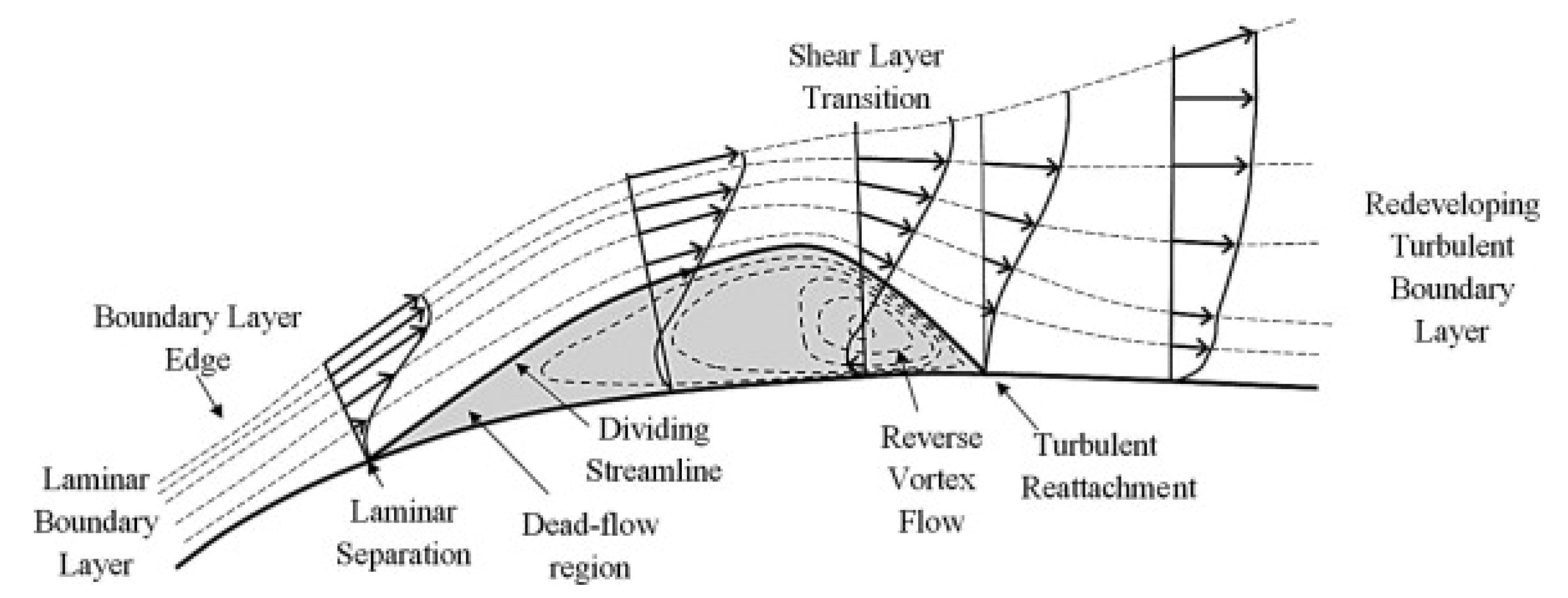
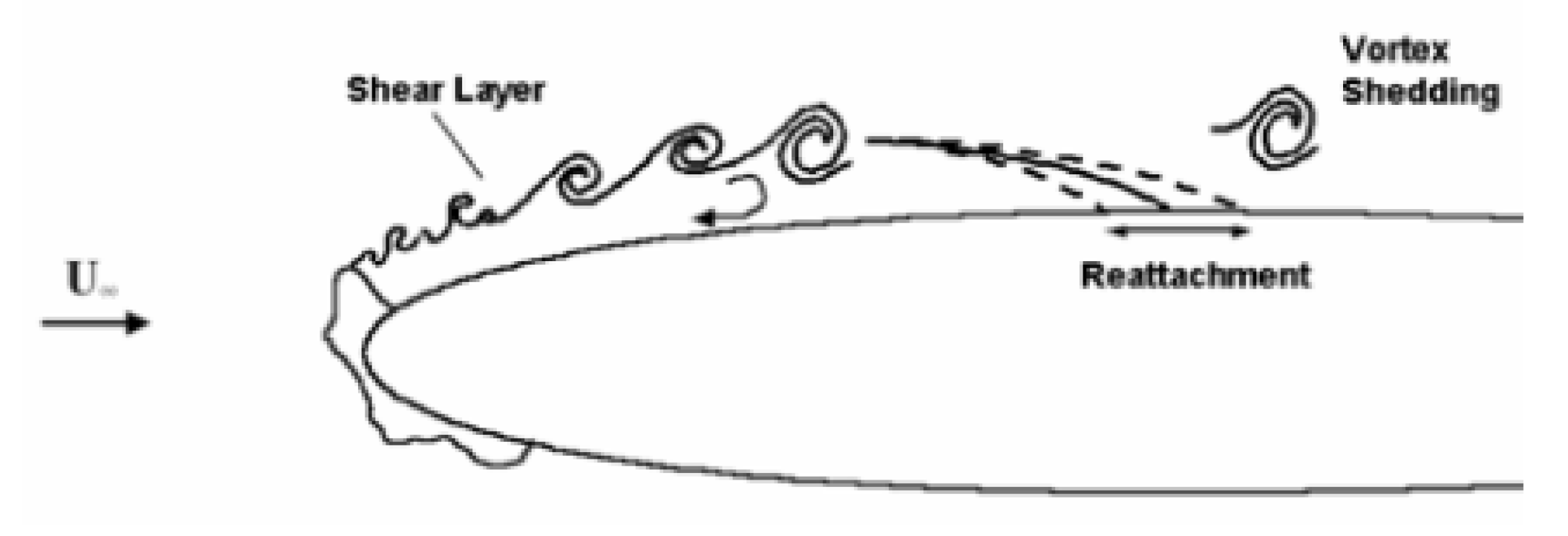


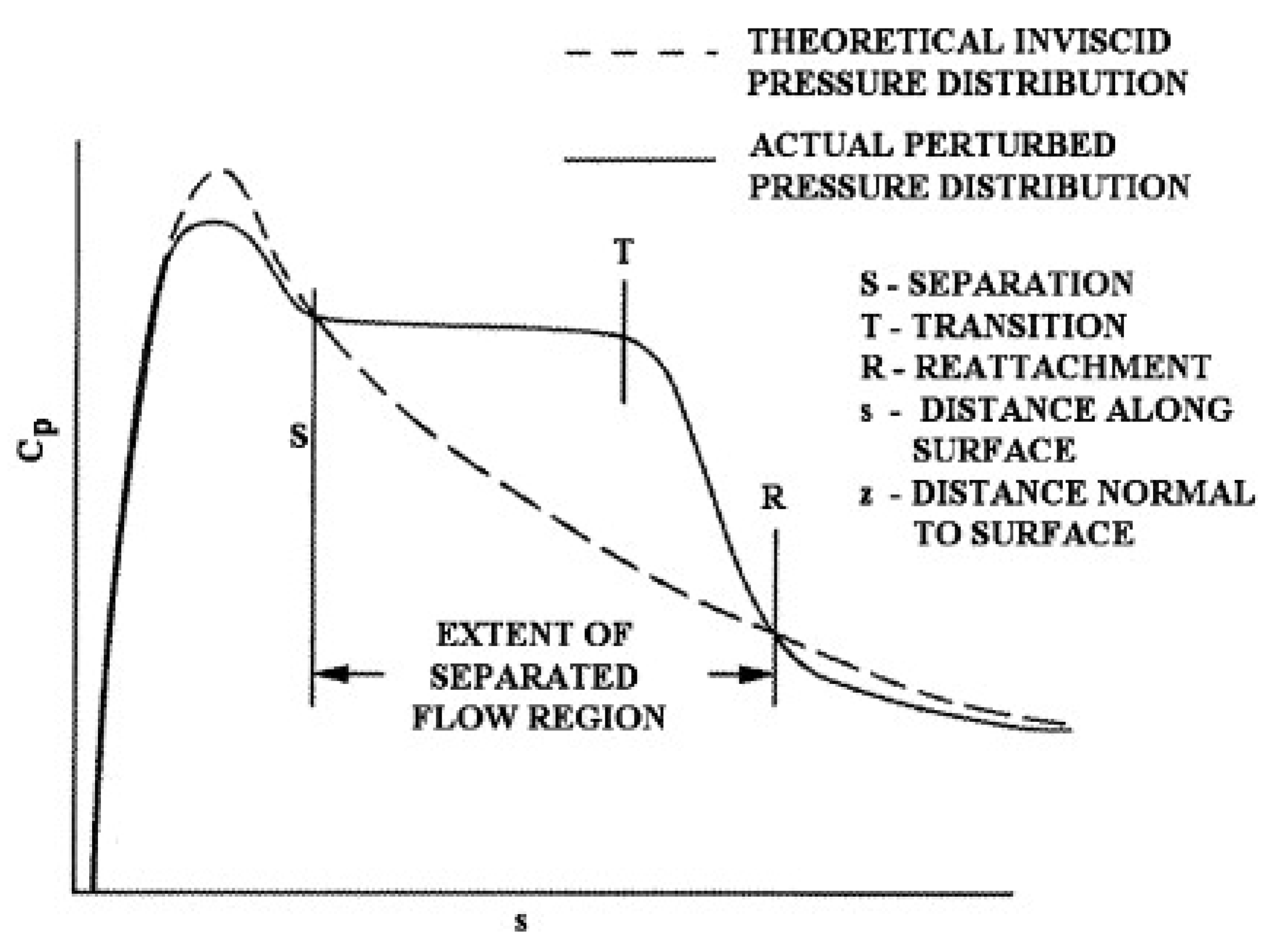
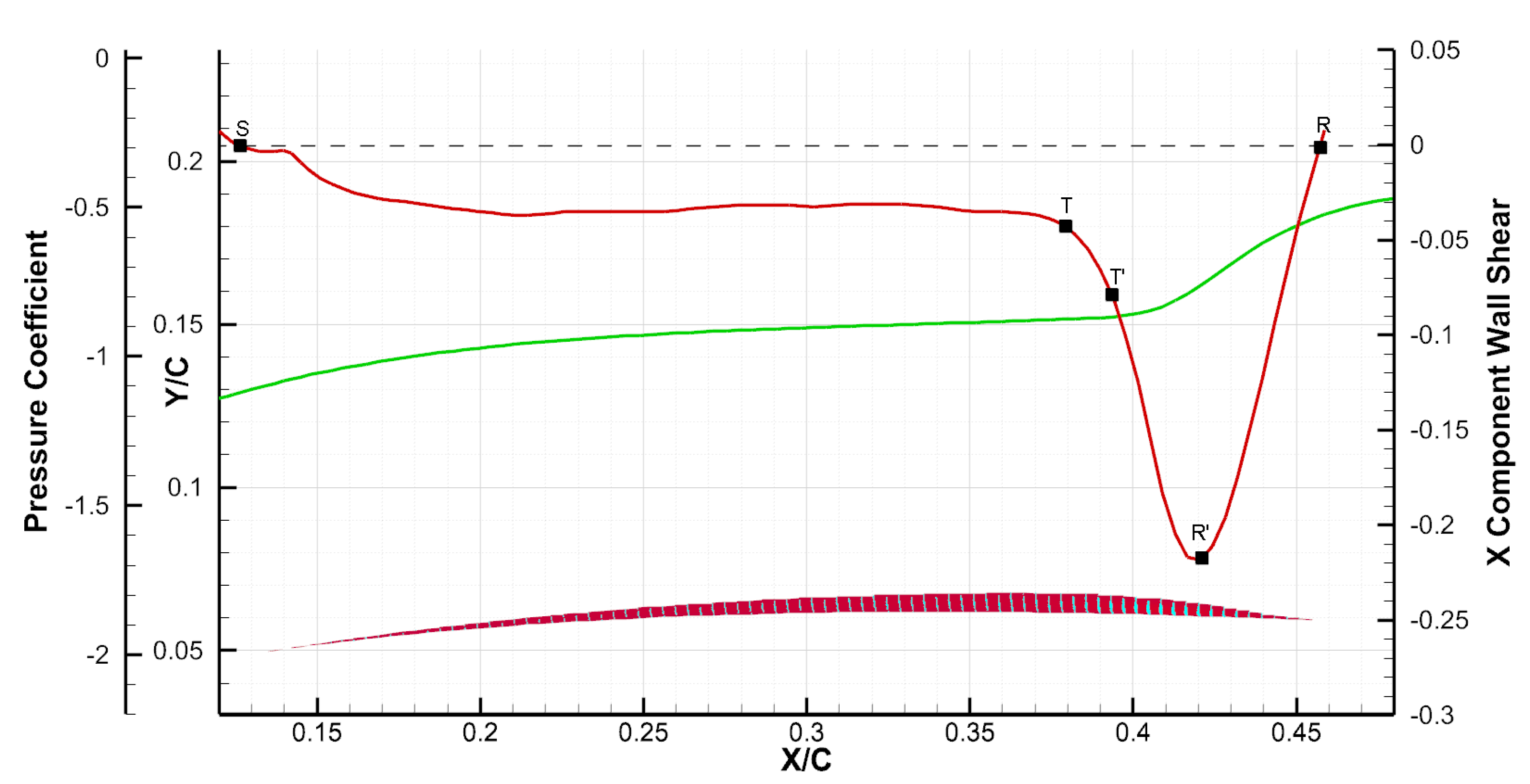

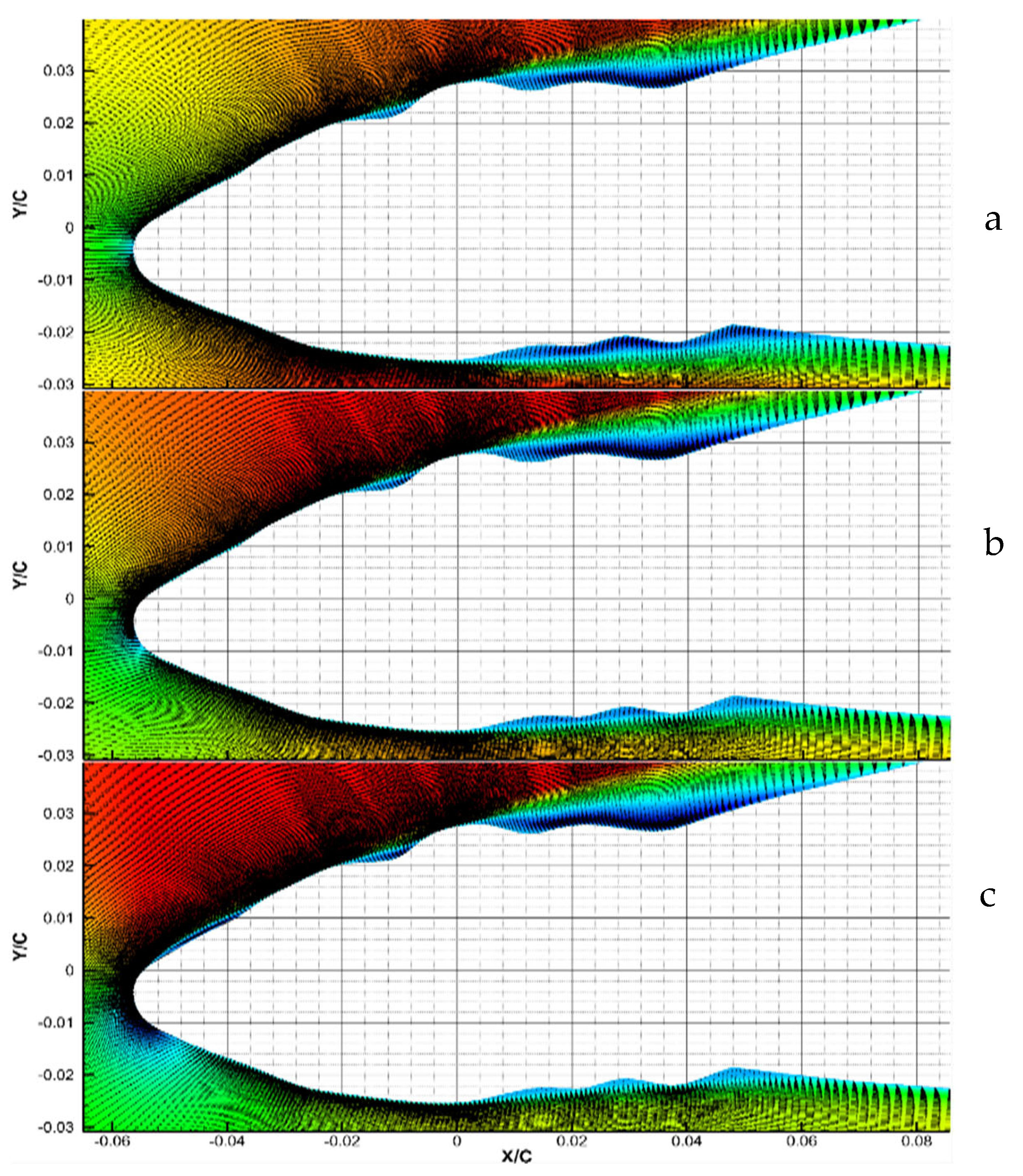
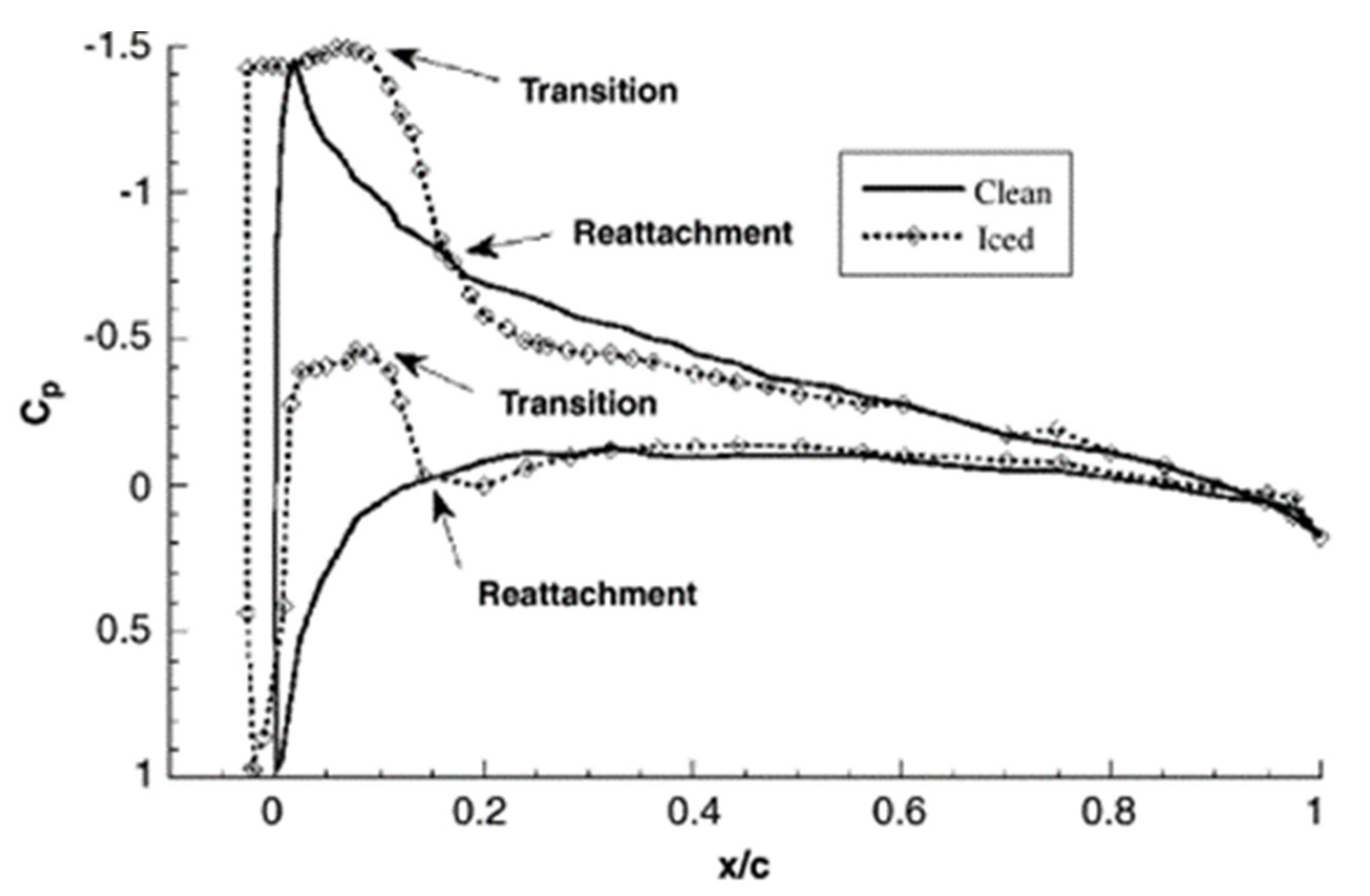

| AOA | 0 Deg | % Diff from Exp | % Diff from LES | 3 Deg | % Diff from Exp | % Diff from LES | 6 Deg | % Diff from Exp | % Diff from LES | ||||||
|---|---|---|---|---|---|---|---|---|---|---|---|---|---|---|---|
| Turbulence Model | Seperation | Seperation | Seperation | Seperation | Reattachment | Seperation | Reattachment | Seperation | Reattachment | Seperation | Reattachment | Seperation | Reattachment | Seperation | Reattachment |
| Experiments | 0.78 | 0.00 | 11.11 | 0.54 | 0.88 | 0.00 | 0.00 | −1.10 | 0.00 | 0.24 | 0.49 | 0.00 | 0.00 | 22.45 | 11.36 |
| LES | 0.70 | −10.00 | 0.00 | 0.55 | 0.88 | 1.11 | 0.00 | 0.00 | 0.00 | 0.20 | 0.44 | −18.33 | −10.20 | 0.00 | 0.00 |
| SA | - | - | - | - | - | - | - | - | - | - | - | - | - | - | - |
| K-W | - | - | - | - | - | - | - | - | - | - | - | - | - | - | - |
| low re KW | - | - | - | - | - | - | - | - | - | 0.20 | 0.37 | −16.67 | −23.67 | 2.04 | −15.00 |
| Trans KW | 0.73 | −6.41 | 3.99 | 0.53 | 0.87 | −1.85 | −0.68 | −2.93 | −0.68 | 0.20 | 0.46 | −16.67 | −6.73 | 2.04 | 3.86 |
| gamma | 0.69 | −11.54 | −1.71 | 0.51 | 1.00 | −5.56 | 13.64 | −6.59 | 13.64 | 0.19 | 0.47 | −21.25 | −4.69 | −3.57 | 6.14 |
| lowre gamma | 0.65 | −16.67 | −7.41 | 0.51 | 1.00 | −5.56 | 13.64 | −6.59 | 13.64 | 0.18 | 0.47 | −25.00 | −4.49 | −8.16 | 6.36 |
| k-kl-w | 0.68 | −12.82 | −3.13 | 0.47 | 1.00 | −12.96 | 13.64 | −13.92 | 13.64 | 0.16 | 0.50 | −33.33 | 2.86 | −18.37 | 14.55 |
| algebraic | 0.75 | −3.85 | 6.84 | 0.55 | 0.78 | 1.85 | −11.02 | 0.73 | −11.02 | 0.20 | 0.40 | −16.67 | −19.18 | 2.04 | −10.00 |
| low re algebraic | 0.77 | −1.28 | 9.69 | 0.48 | 1.00 | −11.11 | 13.64 | −12.09 | 13.64 | 0.19 | 0.47 | −20.83 | −4.69 | −3.06 | 6.14 |
| AOA | 0 Deg | 3 Deg | 6 Deg | |||||||||
|---|---|---|---|---|---|---|---|---|---|---|---|---|
| Turbulence Model | Seperation | Reattachment | % Diff from Exp | % Diff from LES | Seperation | Reattachment | % Diff from Exp | % Diff from LES | Seperation | Reattachment | % Diff from Exp | % Diff from LES |
| Experiments | 0.00 | 0.10 | 0.00 | 3.09 | 0.00 | 0.10 | 0.00 | −15.97 | 0.00 | 0.14 | 0.00 | 6.92 |
| LES | 0.00 | 0.10 | −3.00 | 0.00 | 0.00 | 0.12 | 19.00 | 0.00 | 0.00 | 0.13 | −6.47 | 0.00 |
| SA | −0.02 | 0.05 | −46.00 | −44.33 | −0.02 | 0.06 | −41.00 | −50.42 | −0.05 | 0.07 | −51.44 | −48.08 |
| K-W | −0.02 | 0.06 | −37.50 | −35.57 | −0.02 | 0.07 | −30.50 | −41.60 | −0.05 | 0.07 | −51.44 | −48.08 |
| low re KW | −0.02 | 0.08 | −20.00 | −17.53 | −0.02 | 0.08 | −25.00 | −36.97 | −0.05 | 0.09 | −32.37 | −27.69 |
| Trans KW | −0.02 | 0.08 | −22.50 | −20.10 | −0.02 | 0.08 | −25.00 | −36.97 | −0.05 | 0.08 | −45.32 | −41.54 |
| gamma | −0.02 | 0.07 | −27.00 | −24.74 | −0.02 | 0.08 | −18.00 | −31.09 | −0.05 | 0.09 | −35.25 | −30.77 |
| lowre gamma | −0.02 | 0.07 | −30.00 | −27.84 | −0.02 | 0.08 | −23.00 | −35.29 | −0.05 | 0.09 | −34.53 | −30.00 |
| k-kl-w | −0.02 | 0.08 | −23.00 | −20.62 | −0.02 | 0.11 | 12.00 | −5.88 | −0.05 | 0.08 | −43.17 | −39.23 |
| algebraic | −0.02 | 0.07 | −35.00 | −32.99 | −0.02 | 0.07 | −30.50 | −41.60 | −0.05 | 0.08 | −43.88 | −40.00 |
| low re algebraic | −0.02 | 0.06 | −44.50 | −42.78 | −0.02 | 0.06 | −35.60 | −45.88 | −0.05 | 0.08 | −45.68 | −41.92 |
Disclaimer/Publisher’s Note: The statements, opinions and data contained in all publications are solely those of the individual author(s) and contributor(s) and not of MDPI and/or the editor(s). MDPI and/or the editor(s) disclaim responsibility for any injury to people or property resulting from any ideas, methods, instructions or products referred to in the content. |
© 2024 by the authors. Licensee MDPI, Basel, Switzerland. This article is an open access article distributed under the terms and conditions of the Creative Commons Attribution (CC BY) license (https://creativecommons.org/licenses/by/4.0/).
Share and Cite
Muhammed, M.; Virk, M.S. On the Fidelity of RANS-Based Turbulence Models in Modeling the Laminar Separation Bubble and Ice-Induced Separation Bubble at Low Reynolds Numbers on Unmanned Aerial Vehicle Airfoil. Drones 2024, 8, 148. https://doi.org/10.3390/drones8040148
Muhammed M, Virk MS. On the Fidelity of RANS-Based Turbulence Models in Modeling the Laminar Separation Bubble and Ice-Induced Separation Bubble at Low Reynolds Numbers on Unmanned Aerial Vehicle Airfoil. Drones. 2024; 8(4):148. https://doi.org/10.3390/drones8040148
Chicago/Turabian StyleMuhammed, Manaf, and Muhammad Shakeel Virk. 2024. "On the Fidelity of RANS-Based Turbulence Models in Modeling the Laminar Separation Bubble and Ice-Induced Separation Bubble at Low Reynolds Numbers on Unmanned Aerial Vehicle Airfoil" Drones 8, no. 4: 148. https://doi.org/10.3390/drones8040148
APA StyleMuhammed, M., & Virk, M. S. (2024). On the Fidelity of RANS-Based Turbulence Models in Modeling the Laminar Separation Bubble and Ice-Induced Separation Bubble at Low Reynolds Numbers on Unmanned Aerial Vehicle Airfoil. Drones, 8(4), 148. https://doi.org/10.3390/drones8040148









